LITTLE TWINS - 1977 - c.1990
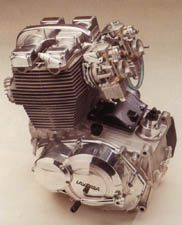 There
is perhaps no Laverda more difficult to explain than the 'little twins'.
Not particularly successful from a commercial point of view, the 500 engine
none-the-less formed the basis for some of the most memorable Laverdas of
all time from the legendary Montjuic of the late 70's to the 750 range that closed the book on Laverda production in 2000.
There
is perhaps no Laverda more difficult to explain than the 'little twins'.
Not particularly successful from a commercial point of view, the 500 engine
none-the-less formed the basis for some of the most memorable Laverdas of
all time from the legendary Montjuic of the late 70's to the 750 range that closed the book on Laverda production in 2000.
The 'little twin' as I call it, traces it's roots back to 1977 when the first Alpina was released, at the time the engine was at the forefront of technology employing double overhead camshafts, four valves per cylinder and a six-speed gearbox. It was fairly oversquare for the time with a bore and stroke of 72x61mm, the crankshaft was a pressed up affair employing roller bearings throughout and fuel was supplied via two Dell'Orto PHF32 carburetors just like the triple. The engine was externally similar to the triple too (though obviously smaller) with the familiar shape to the head and barrel, alternator on the right hand side with the starter motor above and behind all covered by a polished cover. The crankcases were unmistakably 'Laverda' though this time were die rather than sand cast, the left side of the engine was visibly different due to the more efficient and quieter gear primary drive. Compared to the earlier 'big twins' the engine was very light and produced a very different exhaust note due to it's 180 degree crankshaft.
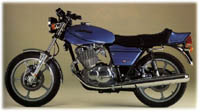 The
rest of the bike broke no new ground but bristled with quality parts as
did every Laverda. A single loop frame was used, 35mm Marzocchi
forks, 'little' twin piston Brembo brakes, ND instruments & switches
and so on- it was obviously a small version of a triple right down to
the 3CL/Jota ducktail. The first Alpina was fairly well received
but without the triple's brute horsepower and burdened with a high price
it struggled in the marketplace. The engine was changed slightly
in 1978 with the addition of a counterbalance shaft, easily recognised
by the 'lump' towards the front of the primary cover, aside from that
the bike remained much the same through to the end of production in 1982,
though the tank changed shape somewhere along the way, probably around
1980.
The
rest of the bike broke no new ground but bristled with quality parts as
did every Laverda. A single loop frame was used, 35mm Marzocchi
forks, 'little' twin piston Brembo brakes, ND instruments & switches
and so on- it was obviously a small version of a triple right down to
the 3CL/Jota ducktail. The first Alpina was fairly well received
but without the triple's brute horsepower and burdened with a high price
it struggled in the marketplace. The engine was changed slightly
in 1978 with the addition of a counterbalance shaft, easily recognised
by the 'lump' towards the front of the primary cover, aside from that
the bike remained much the same through to the end of production in 1982,
though the tank changed shape somewhere along the way, probably around
1980.
The bike was also produced in a 350cc version for no reason other than there being a hefty taxation advantage for 350cc bikes at the time meaning they could obviously be sold at a much cheaper price. This bike was literally just a sleeved down 500 (bore reduced to 60mm and smaller valves etc.), it was externally identical and as such was the same weight as it's bigger brother, sadly this meant that it was fairly uninspiring in the performance stakes. Less than 700 bikes were produced and I'll bet more than half of those have since been converted to 500cc (or more).
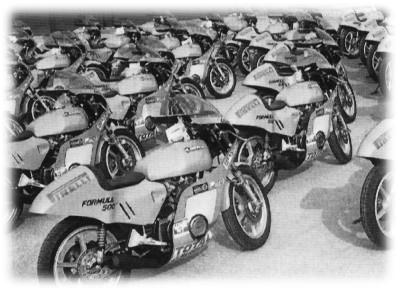 The
500 project really turned around in 1978 with the creation of the Formula
500 for use in the single-make 'Coppa Laverda' race series. The
bike was lightened by the removal of all street gear and the engine output
improved by the usual means of high compression pistons and head/camshaft
modification. The frame and cycle parts remained all but standard,
the standard tank remained though the bike was clothed with a somewhat
odd-looking fairing and a gorgeous sweeping single seat and ducktail.
Potential competitors could buy a bike ready to race at a very attractive
price and the whole series (from spares right down to helmets and fuel)
was heavily subsidised by the many sponsors and the Laverda company itself
who would certainly have lost money on the whole thing but gained a good
deal of publicity.
The
500 project really turned around in 1978 with the creation of the Formula
500 for use in the single-make 'Coppa Laverda' race series. The
bike was lightened by the removal of all street gear and the engine output
improved by the usual means of high compression pistons and head/camshaft
modification. The frame and cycle parts remained all but standard,
the standard tank remained though the bike was clothed with a somewhat
odd-looking fairing and a gorgeous sweeping single seat and ducktail.
Potential competitors could buy a bike ready to race at a very attractive
price and the whole series (from spares right down to helmets and fuel)
was heavily subsidised by the many sponsors and the Laverda company itself
who would certainly have lost money on the whole thing but gained a good
deal of publicity.
From this race series came the Montjuic, perhaps the most rorty and obnoxious bike Laverda ever made. Once
again apparently the brainchild of Roger Slater, the Montjuic (named after
the Spanish racetrack) was to the Alpina what the Jota was to the 3C-
not so dissimilar to the standard bike but with modifications that changed the
character of the bike altogether. 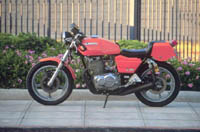 Like the Jota, the Monty's abrasive personality somehow made the standard
bike pale by comparison and as with the triples, it will be 'the hot one'
that will be remembered. The Montjuic was built in two 'series',
the series one wore the later Jota-esque tank and stock sidecovers with
a tail section lifted from the 750SFC and a handlebar fairing that not
only looked rather tacky but also was anecdotally blamed for some of the
bike's 'interesting' handling characteristics. As with most Laverdas
the fairing looks best under the garage workbench. The series two
bike was a much sweeter looking unit with a frame mounted fairing and
one-piece seat and sidecover unit. As far as I know they were much
the same mechanically, with visibly standard frame and cycle parts aside
from the 'Jota' bars, rearset footpegs. The engine breathed
through open bellmouthed Dell'Ortos, radical camshafts, high-compression
pistons, cylinder head modifications and the most wonderfully and obnoxiously
loud two-into-two exhaust system. It was a fire breathing
beast unhappy unless thrashed, those who have never ridden a Montjuic
have not truly lived- it's certainly an experience you will remember for
a lifetime.
Like the Jota, the Monty's abrasive personality somehow made the standard
bike pale by comparison and as with the triples, it will be 'the hot one'
that will be remembered. The Montjuic was built in two 'series',
the series one wore the later Jota-esque tank and stock sidecovers with
a tail section lifted from the 750SFC and a handlebar fairing that not
only looked rather tacky but also was anecdotally blamed for some of the
bike's 'interesting' handling characteristics. As with most Laverdas
the fairing looks best under the garage workbench. The series two
bike was a much sweeter looking unit with a frame mounted fairing and
one-piece seat and sidecover unit. As far as I know they were much
the same mechanically, with visibly standard frame and cycle parts aside
from the 'Jota' bars, rearset footpegs. The engine breathed
through open bellmouthed Dell'Ortos, radical camshafts, high-compression
pistons, cylinder head modifications and the most wonderfully and obnoxiously
loud two-into-two exhaust system. It was a fire breathing
beast unhappy unless thrashed, those who have never ridden a Montjuic
have not truly lived- it's certainly an experience you will remember for
a lifetime.
In 1985, some years after official production of the 500 had ceased, the little twin gained a new lease on life, being light and still reasonably modern it was chosen to power the new OR600 Atlas enduro bike. The engine was now 572cc and boasted many internal revisions the most obvious of which was a twin-choke Dell'Orto automotive carburetor similar to the fruitless Weber experiment by Ducati around the same time. Best of all the engine had been improved internally with revisions to the cooling system and strengthening of the crankcases which were prone to cracking on over-bored and over-revved Montjuics. The bike was an interesting beast and those who have one will say they are great, but with total production of just 450 bikes, those people will be few and far between.
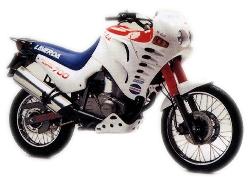 The
engine re-appeared in two prototypes shown by Laverda during the difficult period of the late 80's, trading under the workers co-operative of 'Nuova Moto Laverda'. One was an Enduro bike called the 'El-Cid' and was
an obvious progression from the Atlas, the other a custom styled contraption
named the
The
engine re-appeared in two prototypes shown by Laverda during the difficult period of the late 80's, trading under the workers co-operative of 'Nuova Moto Laverda'. One was an Enduro bike called the 'El-Cid' and was
an obvious progression from the Atlas, the other a custom styled contraption
named the 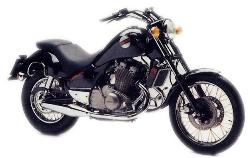 'Hidalgo'.
Both were shitcanned at the time though looking at it now I think the
El-Cid is quite a cool looking unit. The engine had seen further
development with oil-cooling of the head and barrel and was now the 78.5x69mm
668cc that would go on to power the air-cooled Zanè Laverdas, meanwhile the Weber carb had given way to Weber-Marelli fuel injection. In the end neither bike was
produced but the developed engine found it's way to Nico Bakker who had
been asked to design a sportsbike for the new decade, the 1991 650 Sport
was the result.
'Hidalgo'.
Both were shitcanned at the time though looking at it now I think the
El-Cid is quite a cool looking unit. The engine had seen further
development with oil-cooling of the head and barrel and was now the 78.5x69mm
668cc that would go on to power the air-cooled Zanè Laverdas, meanwhile the Weber carb had given way to Weber-Marelli fuel injection. In the end neither bike was
produced but the developed engine found it's way to Nico Bakker who had
been asked to design a sportsbike for the new decade, the 1991 650 Sport
was the result.
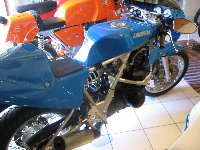 Any story on the 500 would be incomplete without reference to the various
specials that have sprung up over the years. By Laverda standards
the 500 engine was very small, light and not being tremendously vibratory
(especially the later balance shaft models) did not require rubber-mounting
allowing quite some freedom on the chassis front. Perhaps the best
known example of this was the 'SFC600' of the late 80's. German
Uwe Witt (the guy that makes the Witt/DMC ignitions) dreamed of a sweet
handling light sports bike based around a tuned 500 engine. Harris
in England designed and built the frames using chrome-moly tubing that
enveloped the engine and a box section swingarm operating a cantilevered
monoshock, apparently the bike was wonderful to ride and could well have
made a great road or racebike. Witt's hope was that the ailing but
still surviving factory in Breganze could provide Atlas 600-based engines
and he would sell the bikes in street or race trim, but sadly the supply
of engines never appeared and the project slipped quietly away- yet again
we are left with a tantalising 'if only'. Although it is sad that
the production version never eventuated, perhaps you could say that there's
a little bit of that bike in the 90's Laverdas beginning with the 650
Sport of 1991.
Any story on the 500 would be incomplete without reference to the various
specials that have sprung up over the years. By Laverda standards
the 500 engine was very small, light and not being tremendously vibratory
(especially the later balance shaft models) did not require rubber-mounting
allowing quite some freedom on the chassis front. Perhaps the best
known example of this was the 'SFC600' of the late 80's. German
Uwe Witt (the guy that makes the Witt/DMC ignitions) dreamed of a sweet
handling light sports bike based around a tuned 500 engine. Harris
in England designed and built the frames using chrome-moly tubing that
enveloped the engine and a box section swingarm operating a cantilevered
monoshock, apparently the bike was wonderful to ride and could well have
made a great road or racebike. Witt's hope was that the ailing but
still surviving factory in Breganze could provide Atlas 600-based engines
and he would sell the bikes in street or race trim, but sadly the supply
of engines never appeared and the project slipped quietly away- yet again
we are left with a tantalising 'if only'. Although it is sad that
the production version never eventuated, perhaps you could say that there's
a little bit of that bike in the 90's Laverdas beginning with the 650
Sport of 1991.
The little 500 engine served the company well, in its various forms it had perhaps the longest production run of any Laverda engine. The 668 and 750 engines which served out the Laverda company till 2000 had received a goodly dose of development and modern technology but the root of the design still lay on the old drawing boards of the Breganze factory- a testament to the last of the 'Laverda Brothers' designs and one of the most memorable series of Laverda ever made.

